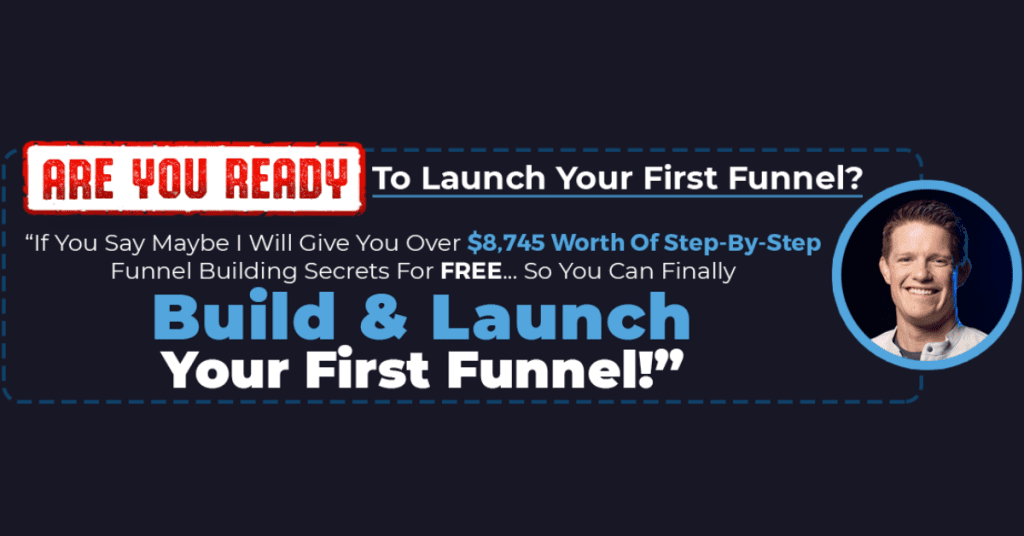You probably heard a lot about how a sales funnel can grow and scale your business online. However, there are so many types of sales funnel out there, which should you be using to get the best result?
One of the most effective sales funnels that we use is called The Value Ladder Sales Funnel.
We will also share the other five types of sales funnel so you can choose the one that can suit your business requirements.
Join the Free Your First Funnel Challenge Now
The Value Ladder Sales Funnel

A sales funnel is a sales process or simply say a series of pages that guide your audiences from getting into your store to making sales.
A typical sales funnel will have 4 stages – Awareness, Interest, Desire, and Action (AIDA). Each stage focuses on doing one thing and bringing the prospects into the next stage to be closed.
Then, throughout the years of creating the sales funnel, we believed the most effective way to create more sales and increase your average cart value is the Value Ladder sales funnel.
Four Stages of Value Ladder
- Bait. You offer the potential customer your lead magnet in exchange for their email address.
- Frontend. You offer the potential customer your least expensive and least valuable product or service.
- Middle. You offer the customer a more expensive and valuable product or service.
- Backend. You offer the customer your most expensive and most valuable product or service.
And at the end of the funnel, you can also offer a subscription service/product that generates recurring revenue monthly. This means you only do the sales once, but you will be getting paid continuously every month. In between the funnel, it’s like a logical decision-making flow where people will say yes/no to your offer.
Here, we do recommend adding products for downsells, upsells, and cross-sells to these five core offers in order to maximize your revenue.
The reason why this sales funnel works so well is that it is not a hard sell for your prospects. It allows you to
- First, start the relationship with that person by offering value for free.
- And then., nurture that relationship by continuing to provide free value via email.
- Finally, build trust by providing progressively more paid value at each stage.
In the end, it is easier to buy something for someone you know and trust compared to a stranger.
Join the Free Your First Funnel Challenge Now
5 Types of Value Ladder Sales Funnel For Growing Business
Now, let’s discuss the different sales funnel for lead generation, selling products/services and webinars.
1. Lead Generation Squeeze Page Funnel
A squeeze page is used to collect the contact details, usually the email addresses of the visitors. This is done by offering a free lead magnet to the visitors in exchange for their contact details.
A squeeze page funnel looks like this:
- Page 1: A squeeze page.
- Page 2: A thank you page.
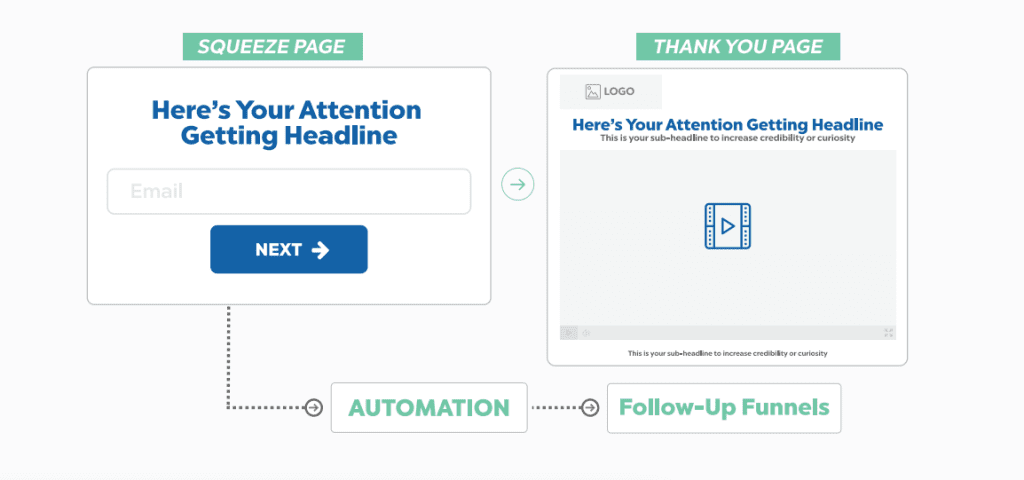
A squeeze page is a simple landing page that usually only consists of these three key elements:
- First, an eye-catching headline that hooks your visitors
- Then, a contact form for your potential customers to enter their email addresses and submit the form.
- Finally, a call-to-action(CTA) button encourages the potential customer to get the lead magnet.
Alternatively, you can also have other elements like a subheadline, sales copy, image etc to explain your offer.
But for a good offer, the basic three elements are enough. The key here is to eliminate anything that might distract your visitors.
The only goal for this page is to get their contact information and convert them into a lead.
A squeeze page funnel is a very effective sales funnel that is used for lead generation for different industries. And, typically for affiliate marketing, a squeeze page funnel is used to bridge your ad or content to the affiliate product.
It is so simple that anyone can start to build almost instantly. And with the help of a sales funnel builder like ClickFunnels, you can build a squeeze page funnel in just a few minutes.
2. Reverse Squeeze Page Funnel
A reverse squeeze page funnel is very similar to a squeeze page funnel. But instead of a squeeze page where you didn’t give much information about the actual lead magnet product, now you explain it on a reverse squeeze page funnel.
A reverse squeeze page funnel looks like this:
- Page 1: A squeeze page.
- Page 2: A thank you page.
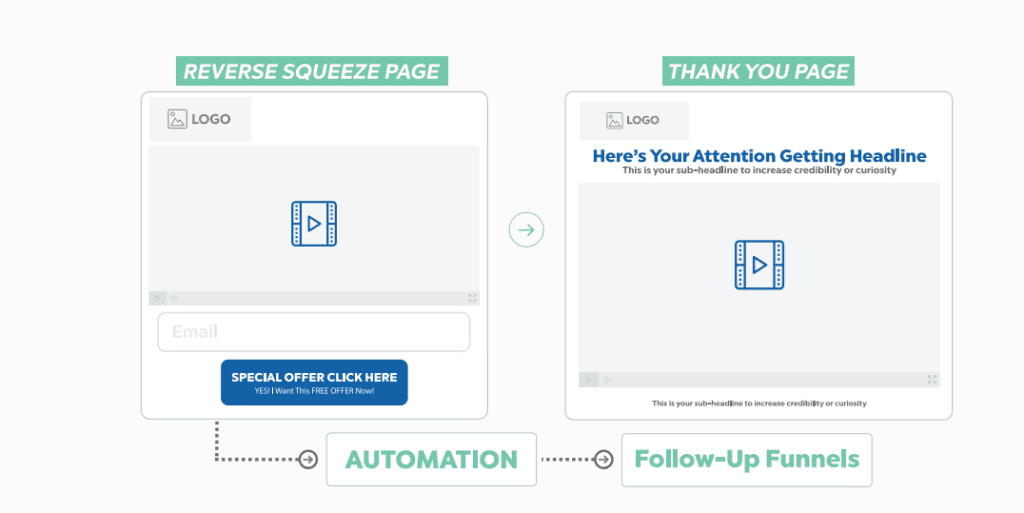
So what’s the difference between the squeeze page funnel and the reverse squeeze page funnel?
- A squeeze page funnel only briefly explains the lead magnet. And then, the visitors only get to know the value after they sign up.
- A reverse squeeze page funnel provides some insight into the free value. And then, only ask for their contact details in exchange for the full lead magnet.
Differing from a squeeze page, a reverse squeeze page normally will have a short video that the potential customer will watch immediately without requiring them to opt in.
Then, you ask them for their email address if they are interested in watching further or want to claim the lead magnet offer.
You may create a free training series and use the first introduction lesson as the video on your reverse squeeze page. Then, if they are interested, they can opt-in to access the entire training for free and provide you with their email address.
Join the Free Your First Funnel Challenge Now
3. Survey Funnel
A survey funnel is a funnel in which you are showing them a series of questions and based on their answers, they will be directed to the respective landing page.
The survey, it’s an interactive session for them. And also, they will think that the result is based on their selections. Although in some cases, the survey funnel can be a fake survey that will direct them to the same landing page, the potential customers will think that it’s a real survey.
And their selection landed on a specific result.
It looks like this:
- Page 1: A series of survey questions.
- Page 2: A squeeze page based on the survey results.
- Page 3: A thank you page based on the survey results.
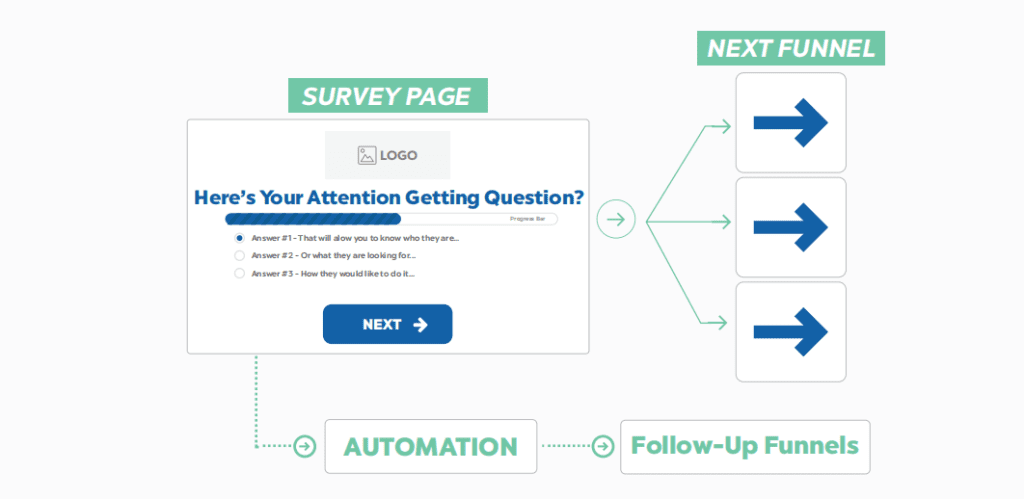
We recommend this survey structure:
- General Questions such as their age group or gender
- Subject-based questions ask about their current situation.
- Asking about their background and skill level.
- Their current struggle and problem.
This structure starts from a general question to a specific question so your target customers will not feel uncomfortable with the survey as they just know about you. Slowly when they are going through the survey, you can ask more about their struggle and provide them with the related solution aka your product/solution.
A survey funnel is great for creating engagement and providing customized results based on a personal challenge.
4. Product Launch Funnel
A product launch funnel is a sales funnel designed specifically for product launches.
Differing from a normal product sales page, a product launch funnel is like a new movie release where there are a few trailers before the actual release.
The trailer will be the video sales letter to reveal the product part by part. And at the end of the final video, you will present them with the product offer.
With this, your potential buyers are following through with the entire product launch process. If your first few videos are able to catch their attention, they will be looking forward to your upcoming videos and also waiting for your product launch.
Here’s what the product launch funnel looks like:
- Page 1: A squeeze page.
- Page 2: Video #1.
- Page 3: Video #2.
- Page 4: Video #3.
- Page 5: Video #4.
- Page 6: A product order page.
- Page 7: An order confirmation page.
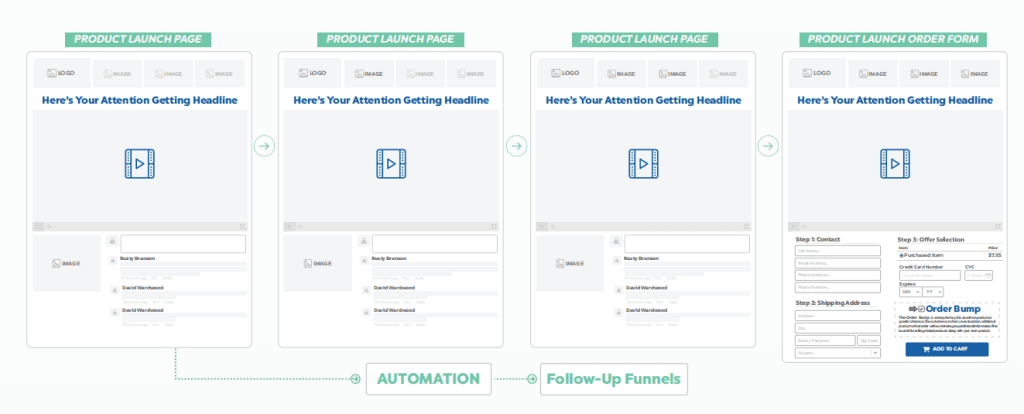
A product launch video sequence is just like telling the backstory about your product, including the product creation and how it can benefit them.
We recommend structuring the video sequence like this:
Video #1:
Explain your business and your background. Tell them a story of how they will benefit from your product. People will only care about themselves. They don’t care what happens to you, but how it will work for them. At the end of the video, you can bring up the common objections they might have, and promise to answer in the following video.
Video #2:
Answer the most common objections and share how your past customers benefited from your product. And show their interview or feedback on your product.
Video #3:
At this stage, you can reveal a bit about your product and explain what this product can do for them. Then foreshadow the next video.
Video #4:
Reveal the secret. Now, you should reveal what is the product and what the product will do. And then, add a CTA button for them to be directed to the sales order page to complete the purchase.
In between each video, remember to leave a bait at the end of the video so they will look for the next video. Also, you should tell them when to expect the next video. And leave a gap of one to two days for each video so they will be hooked.
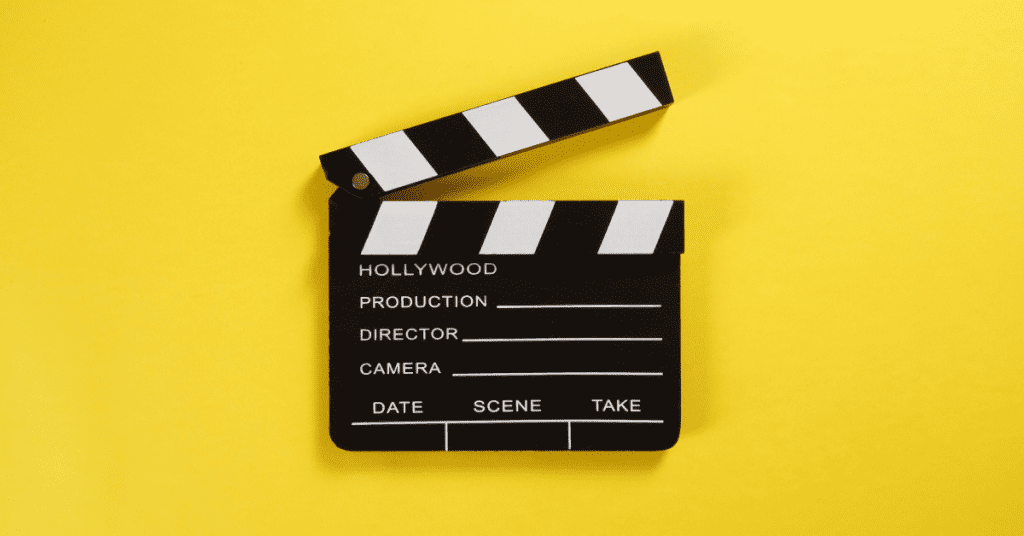
If you are not comfortable making the video, or the video is not high quality, then you may use the email option.
Instead of the product launch funnel, you can use a tripwire funnel to launch your product.
For this, you can use a three-page tripwire funnel.
- Page 1: A squeeze page.
- Page 2: A product order page.
- Page 3: An order confirmation page.
Instead of sending videos to introduce the product, you are sending them out as emails. For each email, you are building the bridge between them and the product. The process is similar, but the way of presenting it is different.
Pro tips: You may use the Soap Opera Sequence for the video creation and email sequence.
To learn more about how to write effective emails, you can get a free copy of “Copywriting Secrets”.
5. Webinar Funnel
A webinar is the most effective way to sell a high-ticket product. People who join your webinar and stay until the end will likely buy from you. They didn’t pay for the webinar, but they already invested their time to join the webinar.
A webinar funnel is a sales funnel in which you promote the free webinar as your lead magnet.
Here’s what it looks like:
- Page 1: A webinar registration page to sell your free webinar ticket.
- Page 2: A thank you page and reminder for the upcoming webinar.
- Page 3: A webinar page.
- Page 4: A product order page.
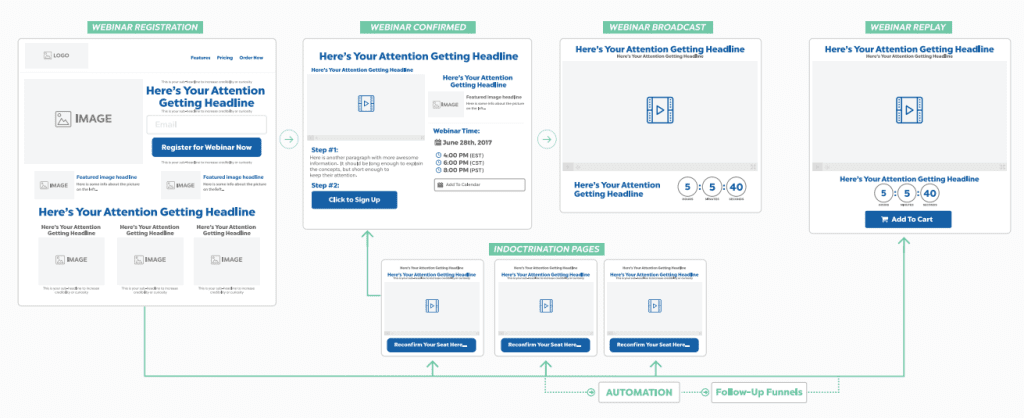
Other than the 4 main pages, the follow-up emails are the most important to remind the participants to join the webinar on time. Not only that but during the period after they registered and the actual webinar, you should send out emails to build rapport with them.
For the webinar, we suggest that you run the live webinar at least once every week and record the session. And then, you can use the recorded webinar for people who just signed up and want to join the webinar instantly.
We recommend doing it live every week so that you can review the webinar script and optimize it until you get the best webinar script. Ideally, you should review word by word and see what works and what’s not.
Here are a few tips on how to create a high-converting webinar funnel:
Provide a lot of free value in the webinar.
A webinar or a live event is a session where your potential customers will be with you for one to two hours or even days and listen to your pitch. Those who registered and joined your webinar actually put lots of effort into joining it on time. They might sacrifice their other activities to join it on time. Hence, don’t upset them or they will leave forever.
In your webinar, you want to demonstrate how much value you are providing them for the free session. And prove to them that your product is worth the price and that there will be more value in the paid product. Not only that, when someone joins a webinar, paid or free, they are expecting to learn something. Make sure you satisfy their expectation. And they will trust you as the authority in your niche.
Use a proven webinar script

For the entire webinar, you are not going to talk about the product or service that you are going to sell at all. Instead, you should focus the entire session to teach them something. And, only at the end of the session, do you start pitching your product and service.
You can do this by using the script below:
“We are almost ending the session today. I hope that you enjoyed the session and learned something today. But before you leave, I’d like to offer you guys something that I’m really excited about. Something that has benefited many people worldwide and you will definitely benefit from it as well. But I don’t want to do it without your permission. Is that ok for me to share a bit about the {product/service}? Just type ”YES” in the chat bar”
At this point in time, since you already provided them with so many values in the session, most will say “YES”. Even if there is no one that says “YES”, you can still proceed with the pitching
“Well, I don’t want to take up too much of your time. But I really think this is going to be a game-changer for you. I will just spend 10 minutes showing you this offer I put together?”
Now if there is little no one that replies “YES”.
Then you have a problem. Your webinar fails and you fail. It would be best if you go back to the drawing board and see what was wrong with your webinar presentation.
Follow Up After Your webinar

And now, if some of the attendees bought, congrats. For those who can’t make up their mind and make a purchase instantly, you definitely need to follow up with them.
Listen to their objections and why they cannot make up their mind. By getting this feedback, you can address it in your next webinar and your email sequence to get them to buy your product or service.
And for all the attendees, whether they purchase your product or not, you should continue to nurture them and build relationships with them via email. In your email, you should always provide value to them and build your credibility.
That way, you will be on their radar and when they need a solution, you are there for them.
Also, if you want to learn more about growing your online business via webinar funnels, check out the “Perfect Webinar Secrets”.
Final Thought – How To Build Your First Sales Funnel?
Starting to build a sales funnel from scratch can be a nightmare.
That’s why I would like to share with you a free challenge.
You can get started with the free 5-day “Your First Funnel Challenge”.
In the challenge, you will learn different topics daily
- DAY 1: Funnel Hacking…
- DAY 2: Your First Funnel…
- DAY 3: Hook, Story, Offer…
- DAY 4: Irresistible Ads!
- DAY 5: Do It Now…!
And then, at the end of the challenge, you will have your first sales funnel, sales copy, email sequence, and ads all ready to launch.
